USGS geologist Graham Lederer (L) wrote a song about the expedition while floating down the river, and Professor Pat Likut (R), who teaches art at the University of Wyoming, did landscape sketches that he will later turn into oil paintings.
Images
Explore our planet through photography and imagery, including climate change and water all the way back to the 1800s when the USGS was surveying the country by horse and buggy.
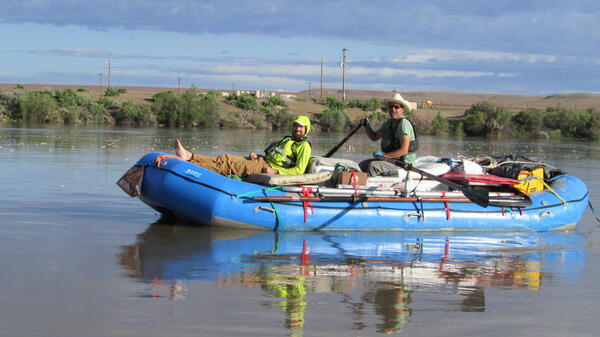
USGS geologist Graham Lederer (L) wrote a song about the expedition while floating down the river, and Professor Pat Likut (R), who teaches art at the University of Wyoming, did landscape sketches that he will later turn into oil paintings.
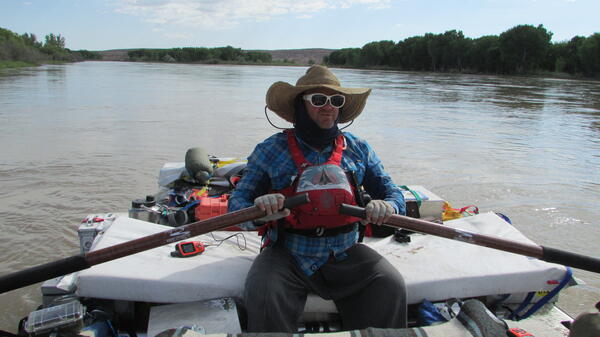
Starting two years ago, Professor Tom Minckley, from the University of Wyoming geology department, conceived and organized the Sesquicentennial Colorado River Exploring Expedition (SCREE), also known as the Powell 150 expedition. The USGS joined as a partner last year.
Starting two years ago, Professor Tom Minckley, from the University of Wyoming geology department, conceived and organized the Sesquicentennial Colorado River Exploring Expedition (SCREE), also known as the Powell 150 expedition. The USGS joined as a partner last year.

Team D braces itself on a windy bluff to watch another beautiful sunset
Team D braces itself on a windy bluff to watch another beautiful sunset

On a calm river with no rapids or impediments, boaters often tie up rafts together in a flotilla or 'party barge' to socialize, share snacks or just enjoy the scenery with a group
On a calm river with no rapids or impediments, boaters often tie up rafts together in a flotilla or 'party barge' to socialize, share snacks or just enjoy the scenery with a group

University of Wyoming grad student (media and communications) Ben Kraushaar is also an accomplished filmmaker, and is making a film of the expedition using both eyelevel shots and lofty drone aerials. He was instrumental in getting equipment of all types donated to the expedition.
University of Wyoming grad student (media and communications) Ben Kraushaar is also an accomplished filmmaker, and is making a film of the expedition using both eyelevel shots and lofty drone aerials. He was instrumental in getting equipment of all types donated to the expedition.
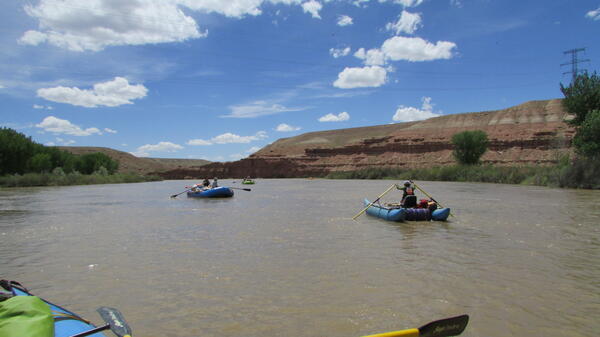
The brick-red, flat-lying Duchesne Formation sandstones dominated the landscape for a couple days. Its bluffs are a favorite nesting spot for cliff swallows, of which we saw many, and peregrine falcons, of which we saw two.
The brick-red, flat-lying Duchesne Formation sandstones dominated the landscape for a couple days. Its bluffs are a favorite nesting spot for cliff swallows, of which we saw many, and peregrine falcons, of which we saw two.
Graham birds from a duckie. USGS isn't only geology and Graham isn't only a geologist!
Graham birds from a duckie. USGS isn't only geology and Graham isn't only a geologist!

We spent the evening listening to the rhythmic sounds of an oil pumpjack straining at the efforts to connect with its Cretaceous past, accompanied by Pat matcing this rhythm on his guitar . Even in the presence of industrial oil extraction, the desert is spectacular at sunset.
We spent the evening listening to the rhythmic sounds of an oil pumpjack straining at the efforts to connect with its Cretaceous past, accompanied by Pat matcing this rhythm on his guitar . Even in the presence of industrial oil extraction, the desert is spectacular at sunset.

Mitch and Graham collect sediment samples on a transect
Mitch and Graham collect sediment samples on a transect

Early June is a great time to view wildflowers in the Utah desert. Although they may have had a vicious appearance, these cacti had absolutely lovely blossoms.
Early June is a great time to view wildflowers in the Utah desert. Although they may have had a vicious appearance, these cacti had absolutely lovely blossoms.
Congratulations to Dr.
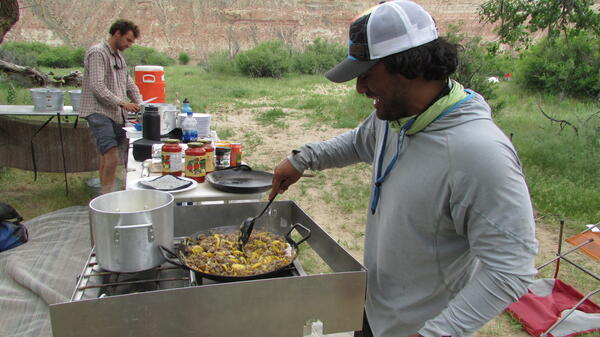
Ben Capelin and Austin Alvarado have multi-faceted roles on the expedition, serving as expert boatmen, talented cooks, evening companions, and contributors to any discussions.
Ben Capelin and Austin Alvarado have multi-faceted roles on the expedition, serving as expert boatmen, talented cooks, evening companions, and contributors to any discussions.

Sampling pre-emergent aquatic insects is not always easy, especially on a river with little cobble substrate. Because of the high water from dam release, a lot of floating driftwood was making its way down river.
Sampling pre-emergent aquatic insects is not always easy, especially on a river with little cobble substrate. Because of the high water from dam release, a lot of floating driftwood was making its way down river.

Florence Bascom joins John Wesley Powell on a 5-day leg of the Powell 150 Expedition, marking the 150th anniversary of the Powell Expedition, an exploration of the Green and Colorado Rivers that ended in the Grand Canyon.
Florence Bascom joins John Wesley Powell on a 5-day leg of the Powell 150 Expedition, marking the 150th anniversary of the Powell Expedition, an exploration of the Green and Colorado Rivers that ended in the Grand Canyon.

Rigging the boats on chilly desert mornings is a slow affair. All our food and gear must be sorted, distributed and carefully packed among the six rafts to be able to accommodate its passengers and so it can all be easily found again when we reach our evening camp.
Rigging the boats on chilly desert mornings is a slow affair. All our food and gear must be sorted, distributed and carefully packed among the six rafts to be able to accommodate its passengers and so it can all be easily found again when we reach our evening camp.

Team D enters the middle of the Uinta basin on Day 2, with Split Mountain still visible. The flow of the river greatly increased that day due to a controlled release at Flaming Gorge Dam. The high flow is meant to carry the larvae of an endangered species of sucker fish into bordering wetlands, where the larvae can grow under more protected conditions.
Team D enters the middle of the Uinta basin on Day 2, with Split Mountain still visible. The flow of the river greatly increased that day due to a controlled release at Flaming Gorge Dam. The high flow is meant to carry the larvae of an endangered species of sucker fish into bordering wetlands, where the larvae can grow under more protected conditions.

Sampling pre-emergent aquatic insects is not always easy, especially on a river with little cobble substrate. Because of the high water from dam release, a lot of floating driftwood was making its way down river. We are testing a new method to sample this substrate for benthic invertebrates to examine questions of species diversity, dispersal and habitat use.
Sampling pre-emergent aquatic insects is not always easy, especially on a river with little cobble substrate. Because of the high water from dam release, a lot of floating driftwood was making its way down river. We are testing a new method to sample this substrate for benthic invertebrates to examine questions of species diversity, dispersal and habitat use.

Synchrotron X-Ray microtomography 3D image (a) and cathodoluminescence slice (b) from the same reentrant-bearing quartz crystal from the Lava Creek Tuff. The reentrants are in darker blue in (a) and the black cavities in (b). Note their relationship to quartz growth bands. Red domains are small magnetite crystals.
Synchrotron X-Ray microtomography 3D image (a) and cathodoluminescence slice (b) from the same reentrant-bearing quartz crystal from the Lava Creek Tuff. The reentrants are in darker blue in (a) and the black cavities in (b). Note their relationship to quartz growth bands. Red domains are small magnetite crystals.
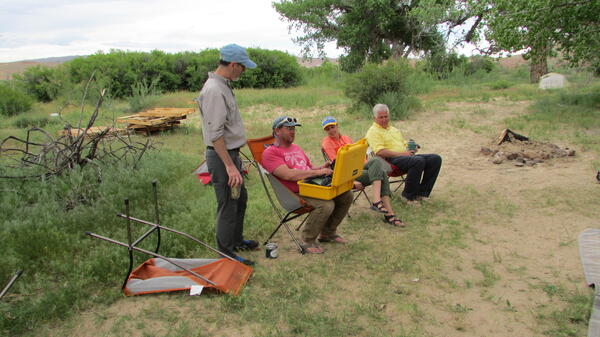
One of the ongoing experiments on the expedition is a bioacoustic survey monitor, which will parse recorded nighttime sounds into species and numbers of individuals. Here Tom Minckley explains it to USGS scientists Mitch Eaton, Jamie Delano, and John Parks.
One of the ongoing experiments on the expedition is a bioacoustic survey monitor, which will parse recorded nighttime sounds into species and numbers of individuals. Here Tom Minckley explains it to USGS scientists Mitch Eaton, Jamie Delano, and John Parks.

The sediment sampling project was intended to provide insight into the presence of microplastics in the Colorado River basin. Samples were collected at every campsite that had an adequate supply of sand.
The sediment sampling project was intended to provide insight into the presence of microplastics in the Colorado River basin. Samples were collected at every campsite that had an adequate supply of sand.
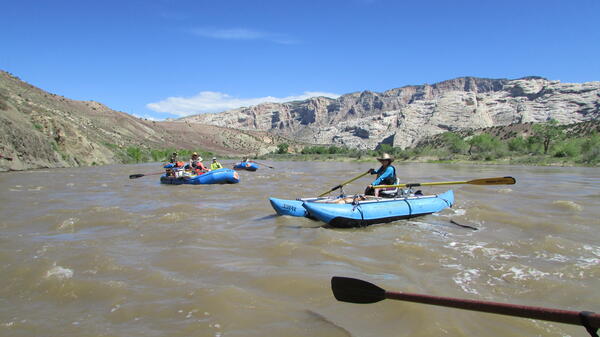
In high-flow conditions, Team D took off from Split Mountain campground in 6 rafts. Split Mountain is shown in the background.
In high-flow conditions, Team D took off from Split Mountain campground in 6 rafts. Split Mountain is shown in the background.



